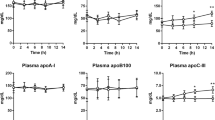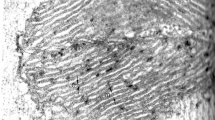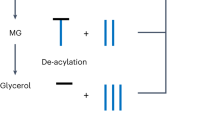Abstract
THE enzyme lipoprotein lipase (LPL) can be demonstrated in serum after the injection of small amounts of heparin into the intact animal1. The addition of heparin to blood alone does not result in a similar rise in LPL activity. These findings have led to the concept that in vivo the enzyme is located in certain tissues from which it can be released into the blood by administration of heparin. The enzyme uses triglyceride as substrate, in chylomicrons or serum lipoproteins or in emulsions which have been “activated” by prior incubation with serum. LPL catalyses the hydrolysis of triglycerides to free fatty acids (FFA) and is characterized and differentiated from other lipases by the following properties: (i) activation by small amounts of heparin, (ii) inhibition by 0.35–1.0 molar sodium chloride, and (iii) inhibition by protamine. Protamine appears to act by antagonizing heparin, but, on the other hand, sodium chloride is considered to inhibit LPL by a mechanism which is independent of the action of heparin. LPL can be demonstrated directly in rat heart and in adipose tissue1. The results of attempts to measure LPL in rat liver tissue have been unsuccessful or equivocal. Recently, however, we have shown a lipase to be present in acetone powders of rat liver having identical characteristics to LPL of other tissues2. Normally, the enzyme appears to be in an inactive state in the liver but can be demonstrated when large amounts of heparin are added. Because heparin is considered to be a specific activator or prosthetic group of LPL3, destruction of heparin by “heparinase”4 in liver may explain the inactive state of LPL in this organ.
This is a preview of subscription content, access via your institution
Access options
Subscribe to this journal
Receive 51 print issues and online access
$199.00 per year
only $3.90 per issue
Buy this article
- Purchase on Springer Link
- Instant access to full article PDF
Prices may be subject to local taxes which are calculated during checkout
Similar content being viewed by others
References
Korn, E. D., Methods Biochem. Anal., 7, 145 (1959).
Mayes, P. A., and Felts, J. M., Biochem. J., 99, 43P (1966).
Robinson, D. S., Adv. Lipid Res., 1, 133 (1963).
Jaques, L. B., J. Biol. Chem., 133, 445 (1940).
Jeffries, G. H., Quart. J. Exp. Physiol., 39, 261 (1954).
Lequire, V. S., Hamilton, R. L., Adams, R., and Merrill, J. M., Proc. Soc. Exp. Biol. and Med., 114, 104 (1963).
Boberg, J., Carlson, L. A., and Normell, L., Life Sci., 3, 1011 (1964).
Condon, R. E., Tobias, H., and Datta, D. V., J. Clin. Invest., 44, 860 (1965).
Mayes, P. A., and Felts, J. M., Proc. European Soc. for the Study of Drug Toxicity, 7, 16 (1966).
Salaman, M. R., and Robinson, D. S., The Enzymes of Lipid Metabolism (edit. by Desnuelle, P.), 218 (Pergamon Press, Oxford, 1961).
Felts, J. M., and Mayes, P. A., Nature, 206, 195 (1965).
Author information
Authors and Affiliations
Rights and permissions
About this article
Cite this article
FELTS, J., MAYES, P. Release of Lipoprotein Lipase from the Perfused Liver of the Rat. Nature 214, 620–621 (1967). https://doi.org/10.1038/214620a0
Issue Date:
DOI: https://doi.org/10.1038/214620a0
Comments
By submitting a comment you agree to abide by our Terms and Community Guidelines. If you find something abusive or that does not comply with our terms or guidelines please flag it as inappropriate.



